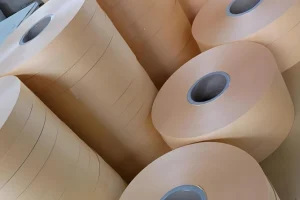
Introduction
Overview of Electrical Insulation Paper as a Crucial Component
Electrical insulation paper is meticulously engineered to deliver dependable insulation across diverse applications. Crafted from processed cellulose fibers, it achieves both precise dielectric strength and thermal stability. Consequently, it is widely applied in transformers, motors, generators, and essential electrical equipment. This application ensures critical electrical insulation exactly where it is needed most. Therefore, electrical insulation paper plays a crucial role in maintaining the reliability and performance of electrical systems.
Key Features of Electrical Insulation Paper
Electrical Insulation Properties:
Insulation paper is specifically engineered to provide crucial insulation properties that ensure the safe and reliable operation of electrical equipment. Its primary functions include:
Ability to Withstand High Voltages: Insulation paper is engineered to withstand high voltages, thus preventing electrical current from passing through. This essential property helps to prevent electrical breakdowns and maintain circuit integrity by effectively isolating conductive materials. As a result, it significantly reduces the risks of short circuits and electrical faults. Therefore, insulation paper plays a crucial role in ensuring the reliable and safe operation of electrical systems.
Prevention of Electrical Leakage and Short Circuits: Insulation paper forms a barrier between conductors and other electrical components, preventing unintended electrical leakage and short circuits. This critical safeguard maintains the performance and longevity of transformers, motors, generators, and other electrical devices. It ensures continuous and safe operation under varying electrical loads and conditions.
Thermal Resistance:
Insulation paper exhibits robust thermal resistance capabilities, making it suitable for use in demanding heat-intensive environments. Key aspects of its thermal performance include:
High Temperature Tolerance for Stable Operation: The paper’s ability to withstand elevated temperatures ensures stable operation of electrical equipment in environments where heat generation is significant. This resilience helps maintain insulation effectiveness over time, even under thermal stress conditions encountered in transformers, electric motors, and other industrial applications.
Application in Heat-Intensive Environments: Insulation paper is widely utilized in industries requiring equipment to operate in environments with high ambient temperatures. Its thermal stability contributes to the reliable performance and longevity of electrical components, reducing the risk of insulation degradation or failure due to heat exposure.
Types and Varieties
Material Composition:
Insulation paper is manufactured from different materials, each offering unique characteristics suited to specific applications:
Cellulose Fibers: Derived from wood pulp, cellulose fibers are a common choice for electrical insulation paper due to their natural dielectric properties and cost-effectiveness. Additionally, they offer good mechanical strength and flexibility. Consequently, these fibers make insulation paper suitable for a wide range of electrical insulation applications. As a result, they balance performance with affordability, ensuring reliable insulation across various electrical systems.
Synthetic Fibers: Synthetic fibers such as aramid (e.g., Nomex) and polyester (e.g., Mylar) are also used in electrical insulation paper. These materials offer enhanced thermal stability, chemical resistance, and mechanical properties compared to cellulose fibers. They are often preferred for applications requiring higher temperature tolerance and stringent performance requirements.
Each material composition is selected based on its specific benefits:
Mechanical Strength: Cellulose fibers provide adequate mechanical strength and flexibility, ensuring the insulation paper can withstand handling and installation without tearing or deforming.
Flexibility: Both cellulose and synthetic fibers offer flexibility, allowing the insulation paper to conform to irregular shapes and maintain contact with conductive elements without compromising insulation performance.
Thickness and Density:
The thickness and density of Insulation paper are critical factors influencing its performance and durability:
Thickness: Thicker papers generally offer higher dielectric strength, which is crucial for withstanding high voltages without electrical breakdown. Consequently, thicker insulation papers are commonly used in applications with stringent insulation requirements. This is essential for ensuring both reliability and safety. Therefore, choosing thicker papers helps to meet the demanding needs of high-voltage environments and enhances overall system performance.
Density: Higher density papers enhance mechanical protection against wear and tear, improving resistance to punctures and abrasions. This extension of service life benefits electrical insulation in demanding environments.
Variations in thickness and density allow manufacturers to tailor insulation paper to meet specific application needs:
- Application-Specific Requirements: Depending on the application, engineers select insulation papers with optimal thickness and density to balance electrical performance, mechanical durability, and cost-effectiveness.
In summary, insulation paper varies in type and composition, thickness, and density. Engineers select the best option for reliable insulation in various environments, crucially impacting equipment performance and lifespan across industries. Effective insulation enhances electrical system safety and reliability, supporting efficient operation and minimizing downtime or failures in critical infrastructure.
Applications of Electrical Insulation Paper
Transformers:
Insulation paper serves as an essential component in transformers, fulfilling several crucial roles to ensure efficient and reliable operation:
Insulating Coil Windings:Insulation paper insulates and protects coil windings in transformers, forming barriers between wire turns and layers to prevent electrical shorts and maintain insulation integrity.
Ensuring Efficient Energy Transfer: Insulation paper isolates conductive materials, optimizing energy transfer in transformers by reducing energy losses from electrical leakage or short circuits. This enhances power transmission and distribution efficiency.
Maintaining Insulation Resistance: One of the critical functions of insulation paper in transformers is to maintain high insulation resistance. This property is crucial for preventing breakdowns and ensuring the long-term reliability of transformers under varying operational conditions.
Extending Operational Life: Effective insulation from insulation paper significantly extends the operational life of transformers by mitigating the effects of electrical stress and environmental factors like temperature variations and humidity, which can degrade insulation over time.
Supporting High Voltage Applications:Transformers in high voltage applications depend on insulation paper with robust dielectric properties to withstand elevated voltages. This paper maintains electrical integrity, ensuring the safety and reliability of electrical distribution networks.
In conclusion, insulation paper is critical for transformers:
- Insulates coil windings
- Ensures efficient energy transfer
- Maintains insulation resistance
- Extends operational life Its role enhances electrical reliability and safety in industries and utilities.